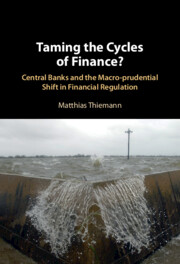Book contents
- Taming the Cycles of Finance?
- Taming the Cycles of Finance?
- Copyright page
- Contents
- Figures
- Tables
- Prologue
- Acknowledgments
- 1 Introduction
- 2 The Changing Regulation of Finance after the Crisis
- 3 The Evolution of Systemic Risk Thinking Pre-crisis
- 4 The Selective Rise of Macro-prudential Ideas in the Wake of the Crisis
- 5 Is Resilience Enough?
- 6 From the Global to the Local
- 7 Taming Liquidity and Leverage in the Shadow Banking Sector
- 8 Into the Upswing
- 9 The Crisis That Wasn’t
- 10 Conclusion
- Appendix: List of Interviews Conducted
- References
- Index
4 - The Selective Rise of Macro-prudential Ideas in the Wake of the Crisis
Published online by Cambridge University Press: 15 February 2024
- Taming the Cycles of Finance?
- Taming the Cycles of Finance?
- Copyright page
- Contents
- Figures
- Tables
- Prologue
- Acknowledgments
- 1 Introduction
- 2 The Changing Regulation of Finance after the Crisis
- 3 The Evolution of Systemic Risk Thinking Pre-crisis
- 4 The Selective Rise of Macro-prudential Ideas in the Wake of the Crisis
- 5 Is Resilience Enough?
- 6 From the Global to the Local
- 7 Taming Liquidity and Leverage in the Shadow Banking Sector
- 8 Into the Upswing
- 9 The Crisis That Wasn’t
- 10 Conclusion
- Appendix: List of Interviews Conducted
- References
- Index
Summary
Chapter 4 zooms in on the attempt of the expert network to shape the post-crisis financial regulatory agenda from the beginning of the crisis in 2007 to 2009. While central to the crisis analysis from the beginning, the chapter shows how most of the macro-prudential regulatory reform efforts were not able to impose themselves, in particular the installation of anti-cyclical policy tools for the shadow banking sector. While efforts seeking to address the interconnectedness of the financial system and increase its resilience by raising capital buffers of systemically important banks were agreed upon at the international level, efforts to address the procyclical character of the financial system were largely transformed into research projects, seeking to prove the existence of such procyclical phenomena. The chapter links these developments to the immaturity of the idea of the financial cycle, which up to that point had remained marginal in academic and regulatory science. Rather than being agreed on at the global level, the installation of monitoring frameworks and anti-cyclical tools was then delegated to the national level, where central banks were placed in charge.
- Type
- Chapter
- Information
- Taming the Cycles of Finance?Central Banks and the Macro-prudential Shift in Financial Regulation, pp. 76 - 102Publisher: Cambridge University PressPrint publication year: 2024



